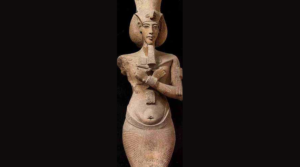In the swirling sands of time, ancient mysteries await unraveling, and histories yearn for reinterpretation. One enigma that continues to pique curiosity is Pharaoh Akhenaten of Egypt‘s Eighteenth Dynasty, a radical reformer who lived over three thousand years ago. This particular investigation ventures beyond the conventional realm of archaeology and enters the domain of gender studies. It seeks to unearth possible signs of gender fluidity or perhaps even a transgender identity in the life of the ancient pharaoh, whose depictions in the art are strikingly different from his predecessors and successors. While this exploration is speculative, it promises to shed light on the complexity of gender identity throughout history, in honor of Pride Month.
Who Is Akhenaten?
Most people know Akhenaten for his radical religious reforms. He turned Egypt from a polytheistic society into a largely monotheistic one. They worshipped Aten, the sun disk. But his unique depictions in statuary and relief have also caught the attention of many. Historians, archaeologists, and gender studies scholars all show interest. Akhenaten’s figure appears androgynous, unlike other pharaohs. This prompts curiosity and speculation: Did he identify with a gender other than his biological one?
Before we go further, let’s clarify something. Ancient Egypt didn’t have our modern understanding of gender identity and transgender individuals. They saw gender differently. Our question is speculative and uses contemporary concepts.
The Unique Artistic Representation of Akhenaten
Typical portrayals of pharaohs show idealized, muscular men. They represent the perfect male form as per ancient Egyptian aesthetics. But depictions of Akhenaten stand out. His statues and carvings depict a figure with wide hips, a rounded belly, narrow shoulders, and a full face. These features differ significantly from the traditional masculine depiction of pharaohs.

Do these features suggest Akhenaten identified more with femininity? It’s a tempting theory. But we must also consider alternative explanations. Some historians believe the unusual artistic style was an aesthetic choice. It could be a symbol of fertility, rebirth, and a direct connection to Aten. This is linked to Akhenaten’s religious revolution. Others suggest Akhenaten may have had a genetic disorder, such as Marfan syndrome. This could explain his distinct physical features.
Gender Fluidity in Ancient Egypt
We should also examine the cultural context of ancient Egypt before dismissing the theory about Akhenaten’s gender identity. Despite a highly stratified civilization, ancient Egyptians seemed to understand gender more fluidly.
We find examples of ancient Egyptian women taking on traditionally male roles, and vice versa. Queen Hatshepsut, another intriguing pharaoh, offers a case in point. Statues and reliefs depict her wearing the traditional male pharaoh’s kilt and false beard. Considering this, Akhenaten’s feminine depiction might reflect gender fluidity in ancient Egypt.
Spiritual and Symbolic Interpretations
We should also consider religious and symbolic explanations. Pharaohs often served as a bridge between gods and people. They embodied both masculine and feminine principles. Akhenaten’s androgynous depiction could symbolize this dual role.
Ancient Egypt highly valued fertility and childbirth. Men and women were both depicted with fertility symbols. Thus, Akhenaten’s feminine appearance could symbolize fertility and creation. This relates to his sun worship.
Romance Between Akhenaton and Nefertiti
And there is the love story between Pharaoh Akhenaton and Queen Nefertiti. They rule together, united not only by power but also by profound love and respect, as evident in their numerous statues and reliefs. In these artistic depictions, they exchange tender glances, caress their children together, and even share intimate kisses – rare scenes in the formal world of ancient Egyptian art. The warmth and affection between them shine through the stone, underscoring their deep, personal bond.

As for their intimate life, ancient Egyptian art and text maintain a level of decorum, offering few explicit details. However, the sensual affection in their portrayals, along with the fact that they had six daughters, suggests a healthy sexual relationship. Unusually for the time, many images show them in affectionate, almost private moments, implying a genuine romantic connection that extended to their private life. However, let’s not forget that their children’s mummies were never found.
Their shared vision for Egypt, their personal affection, and their devotion to their family paint a picture of a royal couple deeply in love, their romance enduring through the ages. It’s a testament to a relationship that was as political and transformative as it was personally intimate and romantic.
An Unanswered Question
In conclusion, we can’t say for certain if Akhenaten was transgender as we understand it today. The question is deeply rooted in an ancient civilization’s cultural, religious, and social context. Our modern perceptions inevitably color our interpretations.
Still, it’s an engaging thought exercise. It invites us to explore and appreciate the complexity of gender identity throughout history. As we celebrate Pride Month, we honor diverse expressions of gender and sexuality, past and present. We remember that identity does not follow a one-size-fits-all pattern.
Importantly, this discussion highlights the value of ongoing research in archaeology, history, and gender studies. It also underscores the value of an open, questioning mind in our journey to understand the diverse human experience.
